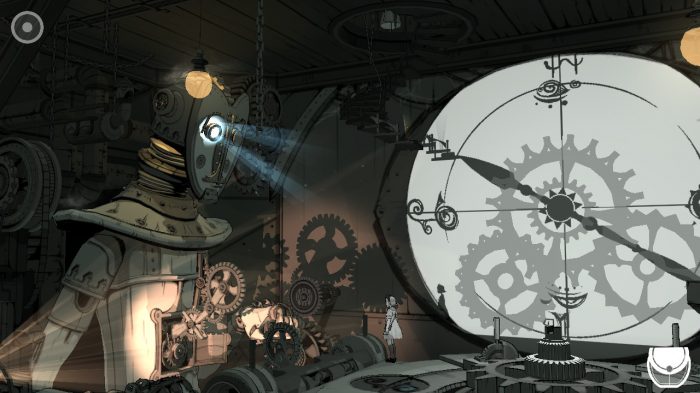When you next fall asleep, consider yourself lucky if you wake from your slumber feeling refreshed after a good night’s rest. Poor Iris is awoken from sleep by a nightmare filled with looming shadows, disturbing puppetry, and a sense of danger. She spots a black cat sat silently in her bedroom, beside a window that has been left ajar. The curiously minded girl rises from her bed and follows the animal as it darts out of her house, through the darkened streets, and into a towering, dilapidated theatre.
After this opening sequence, control of Iris is handed to the player. It is barely a few paces down a staircase however before her (and our) progress is blocked by several crumbled steps. The gap is too wide to jump, but a conveniently placed open book on the floor acts as a magical spot that – when activated – allows Iris’s shadow to take on a life of its own. Free from the limitations of having to walk in a physical space, the shadow can continue its journey along the wall, before reaching another open book back on the staircase, through which Iris can reappear in physical form.

This light and shadow puzzle mechanic acts as the primary source of the challenges that form Iris.Fall, a beautifully composed adventure that – through fixed camera positions – takes Iris and the black cat through many rooms within the old building. For the most part, Iris in her physical form moves within 3D environments, with her shadow-self more limited to being able to navigate within a 2D plane when light is projected on to a wall.
When entering a new room, there is an initial moment of trying to ascertain where Iris needs to head next, to progress the story. An out-of-reach door may be physically beyond Iris’s reach, but if a shadow cast across a wall creates a “bridge” to the door, then a solution is found. The game offers the option of turning on hints; this equates to a little icon that will appear when Iris is near something that she can interact with. Without the hints turned on, you may find yourself searching for clues with a little more pixel precision than you would like.

Iris moves with efficiency within the play area, although at times the camera angle can make it a little tricky to avoid walking into a piece of furniture rather than around it. The girl and her cat are gracefully animated as they explore the many corners and oddities of the game’s setting. Iris is not a fast runner, but each puzzle room is not such a vast area that this becomes an issue.
The puzzles themselves are varied in design, with several “a-ha!” moments as you identify the solution that has been staring you in the face all along. On occasion, the abstract nature of the play environment (and it does get abstract) can cause a frown as you try to solve a conundrum, and sometimes I would stumble across the solution to a puzzle through trial and error, not particularly knowing why I succeeded. There are also instances when a puzzle may require some frustrating traversal back and forth between levers. With Iris.Fall, it is best to not only think outside the box, but indeed on to the box’s shadow too.

Iris.Fall tells its story without dialogue, making use of the environment and player actions to push the adventure forward. It’s like a toy box filled with pictographs, puppets, and mechanical contraptions, although these are toys to be played with delicately. The wrong move in a puzzle can cause Iris’s shadow form to “die”, causing a reset of the puzzle room. It is this gradual increase in tension that adds to the sense of fulfilment when a challenge is resolved.
A palette of greys fills most of the screen, with effective spots of colour that add to the striking visuals. The game draws upon puppet shows and children’s books to convey its distinctive setting. In particular, the themes and art style of The Invention of Hugo Cabret by Brian Selznick came to my mind, a story in which a young boy explores unfamiliar territory, discovering mechanical wonders.

The predominantly monochrome art presents a tale that is both creepy and beautiful, accompanied by a refined piano soundtrack. There are around 2 hours of play on offer to complete Iris’s story, with little incentive to replay the game; no subsequent challenges or collectibles to find. In this respect, Iris.Fall represents a dose of mental gymnastics that you are likely to play through only once. There are clues dotted throughout the game that help allude to who Iris is, but these may not be apparent unless you actively seek them, out of personal interest. Iris.Fall is primarily a puzzle game, and not a test of your platforming skills. Fast reflexes are not required.
It is a fascinating concept to consider the notion of our shadows being able to explore areas that we ourselves cannot reach, but nevertheless, if my shadow and I had the option of experiencing the eerie theatre that Iris visits in the dead of night… I think I’d rather just settle for a good night’s sleep.
Iris.Fall Review £15.29
Summary
Iris.Fall paints a foreboding challenge, guiding Iris and her shadow (with the aid of a cat) through a neat puzzle environment that ultimately may lack the incentive to revisit. But the journey is an intriguing one.

